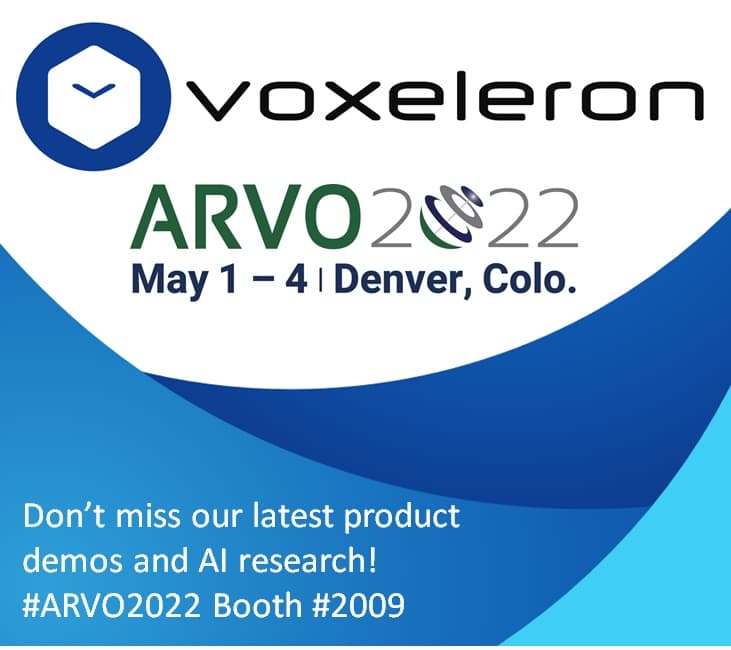Voxeleron at ARVO 2022
Voxeleron at ARVO 2022
It’s great that ARVO commences again as an in person conference, so we very much look forward to interacting with fellow researchers and the community as a whole. In the downtime we have at least been busy so very excited to introduce our recent work at our booth (#2009). In the following we offer a small overview.
iNebulaTM
The headline news is that we are officially now a cloud-based platform provider as we have released iNebulaTM a truly vendor-neutral ophthalmic PACS, viewing, trial-management solution for ophthalmology. Sitting on AWS it is infinitely scalable, secure, searchable and accessible. It facilitates collaborative research, clinical trial management, automated and manual reads (optionally integrates with OrionTM), and realizes FAIR data management (data that is Findable, Accessible, Interoperable, and Reusable). Built on the world’s first ophthalmic graph database, relationships among data can evolve and be learned over time, which, in conjunction with the Voxeleron-supported post-hoc analysis ensures maximal information is derived from the combination of data, analysis and clinical annotations, be they from the built in CRF, the SNOMED menu or just from reader notations. In summary:
- View comprehensive trial status and data in real-time
- Streamline workflows to eliminate bottlenecks
- Find new relationships in post-hoc analysis with the world’s only ophthalmic graph database
iNebula is more than a clinical trial workflow platform. In addition to providing real-time access to clinical trial information, Voxeleron is re-imagining how we run and assess clinical trials. With iNebula, we can visualize data across all ophthalmic devices and then leverage the interface to derive correlations between data and clinical outcomes. iNebula’s imaging insights and synthesis of data improves and accelerates the clinical development of exciting new molecules.
– George Magrath, CEO of Lexitas
More details can be found on our product page.
OrionTM
Orion is our ophthalmic image analysis tool which, like iNebulaTM, is device agnostic, thereby supporting the analysis of all image modalities from all devices. It is a significant workflow advantage to be using both the same software and same algorithm to generate OCT-based endpoints, especially when they are proven best-in-class. The integration with a cloud-based platform like iNebula further streamlines workflows making reads faster, more accurate and now decentralized. AI-based approaches add to this advanced platform and new offerings arriving in time for ARVO include:
- Support for user-privileges such as QA and different reader roles, facilitating both blind reads and arbitration of differences.
- Level sets-based foveal avascular zone (FAZ) segmentation added to the existing algorithm based on positive results in the literature.
- Superficial and deep capillary analysis in OCT-A data.
- ZoneDetectTM: user guided 2d segmentation of imported fundus images of any modality.
These just scratch the surface of Orion’s offerings; further details are on its product page.
We evaluated a number of OCT analysis tools across multiple devices and concluded that Orion is superior in many respects. We work closely with the Voxeleron team to use Orion to maximize efficiencies and minimize errors. In partnering with Voxeleron, we are using the most intuitive and accurate common-platform OCT analysis methods available, which provides advantages that are directly passed along to our trial sponsors.
– Jason Slakter, Medical Director at WorldCare Clinical
Posters
The following are the posters we have collaborated on:
- Machine Learning Quantification of Fluid Volume in Eyes with Retinal Vein Occlusion Undergoing Treatment with Aflibercept: The REVOLT study. 1:15 PM – 3:15 PM CDT on Sunday, May 1
- Automated segmentation of retinal nerve fiber layer excluding retinal blood vessels: integrating OCT and OCT Angiography. 4:00 PM – 6:00 PM CDT on Monday, May 2
- Proof of concept analysis of a deep learning model to conduct automated segmentation of optical coherence tomography images for macular hole volume. 2:00 PM – 4:00 PM CDT on Tuesday, May 3


